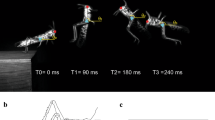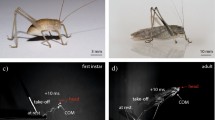Abstract
How do animals control the trajectory of ballistic motions like jumping? Targeted jumps by a locust, which are powered by a rapid extension of the tibiae of both hind legs, require control of the take-off angle and speed. To determine how the locust controls these parameters, we used high speed images of jumps and mechanical analysis to reach three conclusions: (1) the extensor tibiae muscle applies equal and opposite torques to the femur and tibia, which ensures that tibial extension accelerates the centre of mass of the body along a straight line; (2) this line is parallel to a line drawn from the distal end of the tibia through the proximal end of the femur; (3) the slope of this line (the angle of elevation) is not affected if the two hind legs extend asynchronously. The mechanics thus uncouple the control of elevation and speed, allowing simplified and independent control mechanisms. Jump elevation is controlled mechanically by the initial positions of the hind legs and jump speed is determined by the energy stored within their elastic processes, which allows us to then propose which proprioceptors are involved in controlling these quantities.




Similar content being viewed by others
References
Bennet-Clark HC (1975) The energetics of the jump of the locust Schistocerca gregaria. J Exp Biol 63:53–83
Bennet-Clark HC, Lucey ECA (1967) The jump of the flea: a study of the energetics and a model of the mechanism. J Exp Biol 47:59–76
Brackenbury J, Wang R (1995) Ballistics and visual targeting in flea-beetles (Alticinae). J Exp Biol 198:1931–1942
Bräunig P, Hustert R (1985) Actions and interactions of proprioceptors of the locust hind leg coxo-trochanteral joint. I. Afferent responses in relation to joint position and movement. J Comp Physiol A 157:73–82
Bräunig P, Hustert R, Pflüger HJ (1981) Distribution and specific central projections of mechanoreceptors in the thorax and proximal leg joints of locusts. I. Morphology, location and innervation of internal proprioceptors of pro- and metathorax and their central projections. Cell Tissue Res 216:57–77
Burrows M (1969) The mechanics and neural control of the prey capture strike of the Mantid shrimps Squilla and Hemisquilla. Z Vergl Physiol 62:361–381
Burrows M (1995) Motor patterns during kicking movements in the locust. J Comp Physiol A 176:289–305
Burrows M (2003) Froghopper insects leap to new heights. Nature 424:509
Burrows M (2006a) Jumping performance of froghopper insects. J Exp Biol 209:4607–4621
Burrows M (2006b) Morphology and action of the hind leg joints controlling jumping in froghopper insects. J Exp Biol 209:4622–4637
Burrows M, Morris G (2001) The kinematics and neural control of high speed kicking movements in the locust. J Exp Biol 204:3471–3481
Burrows M, Morris O (2003) Jumping and kicking in bush crickets. J Exp Biol 206:1035–1049
Chiel HJ, Beer RD (1997) The brain has a body: adaptive behavior emerges from interactions of nervous system, body and environment. TINS 20:553–557
Collett TS, Paterson CJ (1991) Relative motion parallax and target localisation in the locust, Schistocerca gregaria. J Comp Physiol A 169:615–621
Dickinson MH, Farley CT, Full RJ, Koehl MAR, Kram R, Lehman S (2000) How animals move: an integrative view. Science 288:100–106
Eriksson ES (1980) Movement parallax and distance perception in the grasshopper (Phaulacridium vattatum (Sjostedt)). J Exp Biol 86:337–340
Gray PTA, Mill PJ (1983) The mechanics of the predatory strike of the mantid Heirodula membranacea. J Exp Biol 107:245–275
Heitler WJ (1974) The locust jump. Specialisations of the metathoracic femoral- tibial joint. J Comp Physiol 89:93–104
Heitler WJ (1977) The locust jump. III. Structural specializations of the metathoracic tibiae. J Exp Biol 67:29–36
Heitler WJ, Burrows M (1977) The locust jump. I. The motor programme. J Exp Biol 66:203–219
Katz SL, Gosline JM (1992) Ontogenetic scaling and mechanical behaviour of the tibiae of the African desert locust (Schistocerca gregaria). J Exp Biol 168:125–150
Mallett ES, Yamaguchi GT, Birch JM, Nishikawa KC (2001) Feeding motor patterns in anurans: insights from biomechanical modeling. Am Zool 41:1364–1374
Pflüger HJ, Bräunig P, Hustert R (1981) Distribution and specific central projections of mechanoreceptors in the thorax and proximal leg joints of locusts. II. The external mechanoreceptors: hair plates and tactile hairs. Cell Tissue Res 216:79–96
Pond CM (1972) Initiation of flight in unrestrained locusts, Schistocerca gregaria. J Comp Physiol 80:163–178
Queathem EJ, Full RJ (1995) Variation in jump force production within an instar of the grasshopper Schistocerca americana. J Zool 235:605–620
Rothschild M, Schlein J (1975) The jumping mechanism of Xenopsylla cheopis. Exoskeletal structures and musculature. Phil Trans R Soc Lond B 271:457–490
Rothschild M, Schlein Y, Parker K, Sternberg S (1972) Jump of the oriental rat flea Xenopsylla cheopis (Roths.). Nature 239:45–47
Rothschild M, Schlein J, Parker K, Neville C, Sternberg S (1975) The jumping mechanism of Xenopsylla cheopis. III. Execution of the jump and activity. Phil Trans R Soc Lond B 271:499–515
Santer RD, Yamawaki Y, Rind CF, Simmons PJ (2005) Motor activity and trajectory control during escape jumping in the locust Locusta migratoria. J Comp Physiol A 191:965–975
Smith TL, Povel DGE, Kardong KV (2002) Predatory strike of the tentacled snake (Erpeton tantaculatum). J Zool Lond 256:233–242
Sobel EC (1990) The locust’s use of motion parallax to measure distance. J Comp Physiol A 167:579–588
Van Leeuwen JL, Kier WM (1997) Functional design of tentacles in squid: linking sarcomere ultrastructure to gross morphological dynamics. Phil Trans R Soc Lond B 352:551–571
Acknowledgments
We thank our colleagues at the University of Cambridge for their comments on earlier drafts of this manuscript. We would also like to thank Dr. Maja Zorović for her assistance with filming and Dr. Hillel Chiel for his helpful comments on the manuscript. This work was funded by the Marshall Sherfield Commission and the Human Frontiers Science Program. Experiments comply with the “Principles of animal care”, publication No. 86–23, revised 1985 of the US NIH, and with the laws of the United Kingdom.
Author information
Authors and Affiliations
Corresponding author
Rights and permissions
About this article
Cite this article
Sutton, G.P., Burrows, M. The mechanics of elevation control in locust jumping. J Comp Physiol A 194, 557–563 (2008). https://doi.org/10.1007/s00359-008-0329-z
Received:
Revised:
Accepted:
Published:
Issue Date:
DOI: https://doi.org/10.1007/s00359-008-0329-z




